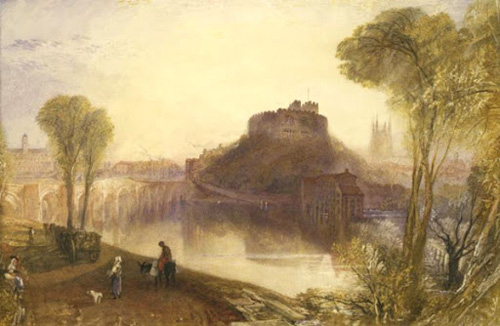




Back to the Staffordshire Page

- The Royal Connection
- Staffordshire Eats
- Owlbut's Birdwatch
- Staffordshire VIPs
 Tamworth Castle is a Norman castle,
funnily enough in the town of Tamworth in Staffordshire. Originally the site was used by Offa, the ruler of Mercia, who built a palace there. The Vikings destroyed
the palaces several times, they were briefly rebuilt, but in 1080 Robert Despenser, a steward to William the Conqueror, built a typical wooden motte and bailey
castle. It is one of the best preserved motte and bailey catles in the country. Later the castle was rebuilt in stone and that is the building that you can see
today.
Tamworth Castle is a Norman castle,
funnily enough in the town of Tamworth in Staffordshire. Originally the site was used by Offa, the ruler of Mercia, who built a palace there. The Vikings destroyed
the palaces several times, they were briefly rebuilt, but in 1080 Robert Despenser, a steward to William the Conqueror, built a typical wooden motte and bailey
castle. It is one of the best preserved motte and bailey catles in the country. Later the castle was rebuilt in stone and that is the building that you can see
today.
Over the years the moat on the town side fell into disuse but in 1810 a new gatehouse was built. A mill was built and this was painted by J M W Turner
in 1832 and you can see his watercolour on the right. In 1897 Tamworth Castle was sold to Tamworth Corporation for the people of Tamworth, at a cost of £3,000.
It opened as a museum two years later in 1899. The Royal connection since Norman times is quite large as the castle was visited by Henry I,
Henry II, Henry III, Edward II, Edward III and James I who was accompanied by his son, later to be Charles I.
![]() Back to the top
Back to the top
The Staffordshire Oatcake, known locally simply as an oatcake, is basically a thick pancake. It is made from oatmeal, flour and yeast and cooked on a griddle or,
in older days, probably on a hotplate over an open fire. They were a major part of the diet of the 18th and 19th century pottery workers.
Wives and older women would make these cakes for the workers, make far too many and then sell the extra ones from the windows of their houses or in the
local market. The oatcakes can have a variety of fillings such as cheese, tomato, onion, bacon, sausage, and egg. Some people sell them with sweet fillings such as
golden syrup, jam or banana, although traditionalists don't like this. One of the advantages of the oatcakes is that, once made and prior to any filling, they can
be reheated, the old-fashioned way being to steam them between two plates over a saucepan of water.
After a steady decline over the last 50 years there now seems to be an oatcake revival. Take advantage of it.
![]() Back to the top
Back to the top
I wanted to be a bit different this week. You won't find a Honey Buzzard in Staffordshire and even if they were there, you
wouldn't know about it. The Honey Buzzard is a large bird of prey and similar to the Buzzard. However there are only 41 breeding pairs in England and so their
nesting sites are kept secret to protect them from stupid people, cruel people, who might take their eggs for their own collection. The bird is a summer visitor
to its breeding sites and spends the winter in Africa.
They are up to 60 cms in length, have a wingspan up to 150 cms and can weigh between 600 grams and just over one kilogram. They eat the insect larvae of
wasps and bees. They have wide wings and a long tail. Their feathers are different colours depending on their age with adults being mainly greyish-brown on the
upperparts and whitish underneath. They have yellow legs and a short, black beak which is hooked. I just wanted you to know that not all birds are safe from
extinction so please don't frighten any of any breed that might be nesting. We need to breed.

Seven random people who were born in Staffordshire in the last 100 years:-
Robbie Williams (Singer), the late Sir Stanley Matthews (Footballer), Anthea Turner (TV Presenter), Phil Taylor (World Champion Darts Player), the late Ian
Fraser Kilmiste, better known as Lemmy (Founder of Motorhead), Eddie Hall (World's Strongest Man 2017) and Nick Hancock (Actor, Comedian and TV Presenter).
![]() Back to the top
Back to the top

